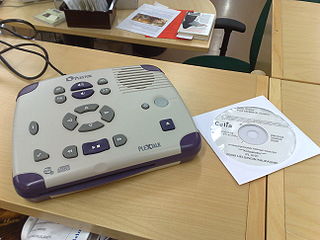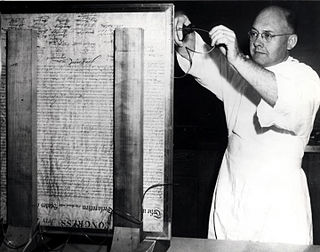In computing, AAP DTD is a set of three SGML Document Type Definitions for scientific documents, defined by the Association of American Publishers. It was ratified as a U.S. standard under the name ANSI/NISO Z39.59 in 1988, and evolved into the international ISO 12083 standard in 1993. It was supplanted as a U.S. standard by ANSI/ISO 12083 in 1995.
ANSEL, the American National Standard for Extended Latin Alphabet Coded Character Set for Bibliographic Use, was a character set used in text encoding. It provided a table of coded values for the representation of characters of the extended Latin alphabet in machine-readable form for thirty-five languages written in the Latin alphabet and for fifty-one romanized languages. ANSEL adds 63 graphic characters to ASCII, including 29 combining diacritic characters.
MARC is a standard set of digital formats for the machine-readable description of items catalogued by libraries, such as books, DVDs, and digital resources. Computerized library catalogs and library management software need to structure their catalog records as per an industry-wide standard, which is MARC, so that bibliographic information can be shared freely between computers. The structure of bibliographic records almost universally follows the MARC standard. Other standards work in conjunction with MARC, for example, Anglo-American Cataloguing Rules (AACR)/Resource Description and Access (RDA) provide guidelines on formulating bibliographic data into the MARC record structure, while the International Standard Bibliographic Description (ISBD) provides guidelines for displaying MARC records in a standard, human-readable form.
A technical report is a document that describes the process, progress, or results of technical or scientific research or the state of a technical or scientific research problem. It might also include recommendations and conclusions of the research. Unlike other scientific literature, such as scientific journals and the proceedings of some academic conferences, technical reports rarely undergo comprehensive independent peer review before publication. They may be considered as grey literature. Where there is a review process, it is often limited to within the originating organization. Similarly, there are no formal publishing procedures for such reports, except where established locally.
The National Information Standards Organization is a United States non-profit standards organization that develops, maintains and publishes technical standards related to publishing, bibliographic and library applications. It was founded in 1939 as the Z39 Committee, chaired from 1963-1977 by Jerrold Orne, incorporated as a not-for-profit education association in 1983, and assumed its current name in 1984.

Digital accessible information system (DAISY) is a technical standard for digital audiobooks, periodicals, and computerized text. DAISY is designed to be a complete audio substitute for print material and is specifically designed for use by people with "print disabilities", including blindness, impaired vision, and dyslexia. Based on the MP3 and XML formats, the DAISY format has advanced features in addition to those of a traditional audio book. Users can search, place bookmarks, precisely navigate line by line, and regulate the speaking speed without distortion. DAISY also provides aurally accessible tables, references, and additional information. As a result, DAISY allows visually impaired listeners to navigate something as complex as an encyclopedia or textbook, otherwise impossible using conventional audio recordings.

Tracing paper is paper made to have low opacity, allowing light to pass through. Its origins date back to at least the 1300s where it was used by artists of the Italian Renaissance. In the 1880s, tracing paper was produced en masse, used by architects, design engineers, and artists. Tracing paper was key in creating drawings that could be copied precisely using the diazo copy process. It then found many other uses. The original use for drawing and tracing was largely superseded by technologies that do not require diazo copying or manual copying of drawings.
The Serial Item and Contribution Identifier (SICI) was a code used to uniquely identify specific volumes, articles or other identifiable parts of a serial. It was "intended primarily for use by those members of the bibliographic community involved in the use or management of serial titles and their contributions". Developed over 1993–1995, NISO adopted SICI as a standard in 1996, then reaffirmed it in 2002. It was withdrawn in 2012.

In conservation, library and archival science, preservation is a set of preventive conservation activities aimed at prolonging the life of a record, book, or object while making as few changes as possible. Preservation activities vary widely and may include monitoring the condition of items, maintaining the temperature and humidity in collection storage areas, writing a plan in case of emergencies, digitizing items, writing relevant metadata, and increasing accessibility. Preservation, in this definition, is practiced in a library or an archive by a conservator, librarian, archivist, or other professional when they perceive a collection or record is in need of maintenance.
William James Barrow was an American chemist and paper conservator, and a pioneer of library and archives conservation. He introduced the field of conservation to paper deacidification through alkalization.
The U.S. Permanent Paper Law, or P.L. 101-423, is a joint resolution calling for the use of acid-free paper for federal records, books, and "publications of enduring value." It was signed into law by President George H.W. Bush in October 1990.
Bleaching of wood pulp is the chemical processing of wood pulp to lighten its color and whiten the pulp. The primary product of wood pulp is paper, for which whiteness is an important characteristic. These processes and chemistry are also applicable to the bleaching of non-wood pulps, such as those made from bamboo or kenaf.

Paper is a thin sheet material produced by mechanically or chemically processing cellulose fibres derived from wood, rags, grasses, or other vegetable sources in water, draining the water through a fine mesh leaving the fibre evenly distributed on the surface, followed by pressing and drying. Although paper was originally made in single sheets by hand, almost all is now made on large machines—some making reels 10 metres wide, running at 2,000 metres per minute and up to 600,000 tonnes a year. It is a versatile material with many uses, including printing, painting, graphics, signage, design, packaging, decorating, writing, and cleaning. It may also be used as filter paper, wallpaper, book endpaper, conservation paper, laminated worktops, toilet tissue, currency, and security paper, or in a number of industrial and construction processes.
The Grey Literature International Steering Committee (GLISC) was established in 2006 after the 7th International Conference on Grey Literature (GL7) held in Nancy (France) on 5–6 December 2005.

ISO 25964 is the international standard for thesauri, published in two parts as follows:
ISO 25964 Information and documentation - Thesauri and interoperability with other vocabulariesPart 1: Thesauri for information retrieval [published August 2011] Part 2: Interoperability with other vocabularies [published March 2013]
In the context of information retrieval, a thesaurus is a form of controlled vocabulary that seeks to dictate semantic manifestations of metadata in the indexing of content objects. A thesaurus serves to minimise semantic ambiguity by ensuring uniformity and consistency in the storage and retrieval of the manifestations of content objects. ANSI/NISO Z39.19-2005 defines a content object as "any item that is to be described for inclusion in an information retrieval system, website, or other source of information". The thesaurus aids the assignment of preferred terms to convey semantic metadata associated with the content object.

The Journal Article Tag Suite (JATS) is an XML format used to describe scientific literature published online. It is a technical standard developed by the National Information Standards Organization (NISO) and approved by the American National Standards Institute with the code Z39.96-2012.
The conservation and restoration of film is the physical care and treatment of film-based materials. These include photographic film and motion picture film stock.
ISO 12083 is an international SGML standard for document interchange between authors and publishers. It features separate Document Type Definitions for books, serials, articles, and math. Derived from AAP DTD, it was first published in 1993, revised in 1994, and last confirmed in 2016.
Acidic paper is paper that had some acidic substances used during the manufacture process. This type of paper, widely used since the mid-nineteenth century, turns yellow in a short time and becomes extremely brittle, which causes huge losses in library and archives collections.
![The acid-free-paper symbol;
.mw-parser-output .monospaced{font-family:monospace,monospace}
U+267E [?] PERMANENT PAPER SIGN Perennial symbol.svg](http://upload.wikimedia.org/wikipedia/commons/thumb/3/33/Perennial_symbol.svg/220px-Perennial_symbol.svg.png)





